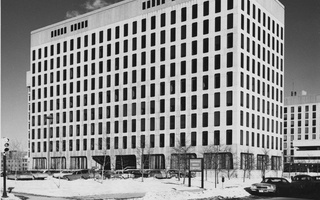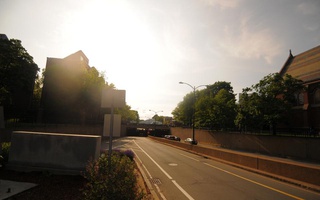This month’s revelations that Boston city authorities would indefinitely close the Long Island Bridge are frustrating and disturbing. The bridge was closed in part because of a dispute between the cities of Boston and Quincy—the island, part of Boston, is connected to the mainland through a bridge whose other terminus is in Quincy. As winter approaches, it is unacceptable that municipal turf wars should endanger Boston’s most vulnerable.
Before the bridge’s closing, 460 homeless Bostonians spent their nights in the Long Island homeless shelter, and many other at-risk city residents are on the island during the day at substance-abuse and transitional housing centers. (The island has no permanent inhabitants and is not open to the public; the city buses shuttle residents onto the island in the evening and back to the city in the morning.)
The Long Island Bridge, built in 1951, has been riddled for decades with structural problems. Recent estimates centered on the figure of $80 million needed to fix the nearly 3,500-foot span. Yet Boston Mayor Martin J. Walsh, like his predecessor, has promised to fix the bridge, no matter the cost. “That’s the only location in the city of Boston that works,” the former mayor said, suggesting that he does not envision new shelters on Long Island’s scale anywhere else in the near future.
Reports that city authorities had closed the bridge and evacuated people from the island before construction began therefore came as a surprise, especially to shelter volunteers. The Mayor’s office cited structural problems with the bridge, and it is now unclear how the city plans to proceed.
What is clear beyond doubt is the bureaucratic tug-of-war behind the bridge story. According to the Boston Globe, "The bridge has long been a source of contention among Boston, Quincy, and the state. The bridge can be reached only through Quincy, but is owned and controlled by the City of Boston, which operates a guardhouse at the entrance.”
Past and present Quincy local leaders have opposed fixing the bridge, calling for the city to demolish it and replace it with ferry service, which they argue would be cheaper. The recent freezing of construction on the bridge, over which the buses need to travel to reach the island, therefore appears to represent a stalemate in the war between Quincy and Boston authorities over control of access to the island.
The closure of the Long Island Bridge is particularly worrying because of its timing. Winter is coming, and meteorologists predict a return of last winter’s vicious “polar vortex,” when temperatures fell below zero for days at a time. City and local shelters, including the Harvard Square Homeless Shelter, have struggled to keep up, often finding they do not have enough beds on colder nights. The city and Commonwealth’s response to shelter overflow has been woefully inadequate. A report last December in the Boston Globe describes the Commonwealth’s policies found that rather than building new and larger shelters, authorities have settled on short-term fixes, shunting families without secure housing to motels. Yet motels are businesses, not aid organizations, and they are poorly equipped to offer other necessary services to the homeless.
The only long-term fix is to guarantee that Boston area shelters themselves have enough beds to house everyone who needs accommodation on the coldest nights, even if Mayor Walsh would prefer to keep these people on Long Island, at arm’s length from the city. In the nearer term, the city must do more to prepare other locations where the homeless can take refuge from the cold.
Read more in Opinion
Realizing RaceRecommended Articles
-
 City Sees Urban Renewal
City Sees Urban Renewal -
Longtime City Clerk To Retire This MonthCambridge City Clerk D. Margaret Drury plans to retire in February after serving in the position for 20 years.
-
 Beautifying Harvard Square
Beautifying Harvard Square -
Johannesburg in Transit“The people who live here understand and appreciate the beauty of Johannesburg,” Tshandu stated. “This is just a glimpse of what makes our city so great.”
-
Tyga Lyrics RewrittenStack city chick, Stack, Stack city chick Ten ten ten books for ya thesis chick Hundred deep pages written, I so quick Thesis writing’s FTW flippin easy trick
-
 Town and Gown
Town and Gown













